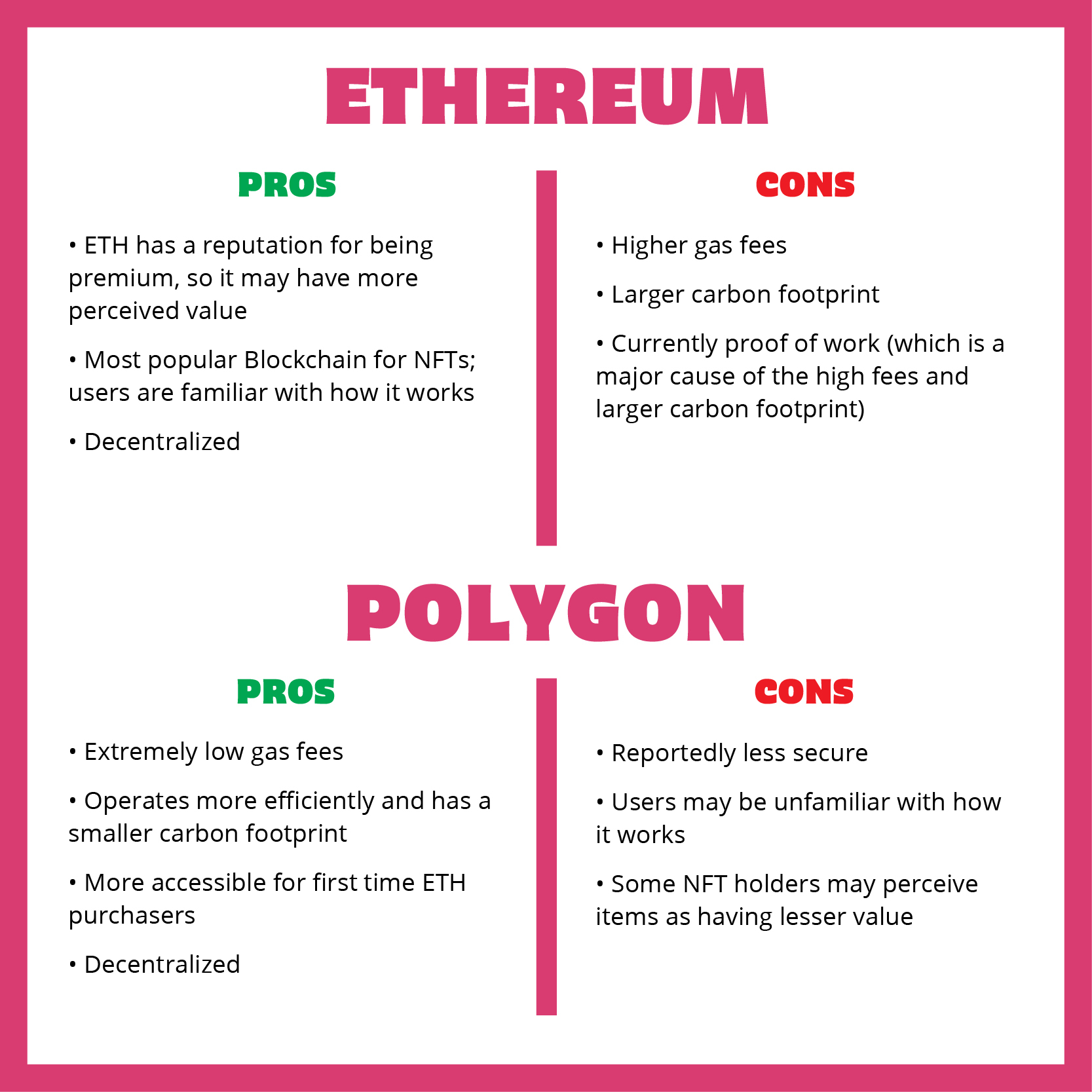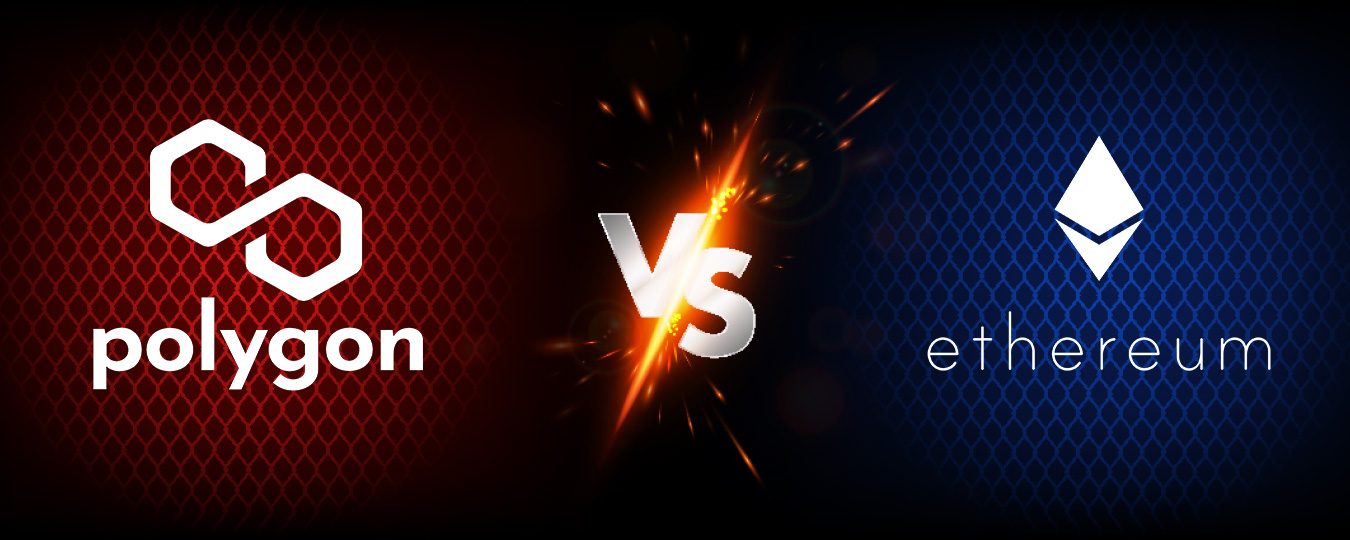You’ve created an incredible collection of NFTs. You’re planning a launch, building a community of future holders, and getting your collection’s name out to the public. These are crucial steps to make your collection hit. Where are you launching your collection?
This can be a complicated topic, and if the finer details of how cryptocurrency works put you to sleep, don’t worry. We will make this quick, easy, and as painless as possible. We’ll talk about each blockchain and point out some of the main pros and cons. By the end, you’ll feel much more comfortable choosing between the two. This is a big decision, so we’ll do our best to help out.
What’s a Blockchain, Anyway?
In the simplest terms, a Blockchain is a database shared among computers. As a database, the Blockchain securely stores information. They can provide secure and decentralized records of transactions and store valuable information about digital items such as NFTs.
Different Blockchain developers go about building these systems in very different ways; however, every blockchain allows for the recording and distribution of digital information in one way or another. This information can be accessed, but it can’t be edited, changed, or destroyed.
Ethereum
Let’s talk about Ethereum. This has been the primary blockchain where NFTs have launched. When an NFT is purchased and minted on a blockchain, the transaction must be approved.
The approval process is necessary to validate the transaction and protect the seller and purchaser involved in the trade. Like everything, this process requires energy. Since no one company is in charge of this process, Ethereum uses a mechanism called Gas Fees to cover those energy costs. One problem with this process is that when there is a high demand for transaction validation, the cost of the gas fees will go up during that time.
This is, without a doubt, one of the highest complaints about the Ethereum Blockchain.
Polygon
This is where Polygon comes in. You can think of Polygon as a side chain or, in industry-standard terms, a Layer 2 solution to Ethereum. From the user perspective, Polygon functions a lot like ETH.
The main value behind Polygon is that you don’t have to pay insanely high gas fees during busy times on the blockchain. For example, on OpenSea, someone can use the Polygon Blockchain without paying any gas fees. If you want to buy an NFT on Polygon, you still have to pay indirect gas fees.
This might seem a little complex, but you will have to bridge standard ETH to Polygon to use Polygon ETH. This bridge will require paying a gas fee, so technically, you are still paying gas to use Polygon; however, the cost will be much less.
Pros and Cons
Hopefully, now you have a better idea about what each of these Blockchains represents in relation to each other. Let’s look specifically at the pros and cons of each Blockchain.

Ethereum - The Pros
Ethereum is the OG blockchain in the NFT space. It has perks. It has a reputation as a premium platform. Many consumers are more likely to see an NFT on the ETH blockchain with a higher value.
Another plus is its sheer popularity. Most NFT holders are now familiar with ETH and understand how it works. Crypto can be overwhelming and notoriously confusing, so this can be a plus if you’re considering selling NFTs.
Finally, ETH is decentralized. It’s a reliable, secure, and fast system you can trust and rely on to handle your NFT-related transactions.
Ethereum - The Cons
As we mentioned earlier in our description of how blockchains work, ETH is notorious for high gas fees. Currently, the Ethereum blockchain operates under a model known as proof of work (PoW). Full details on how this works surpass the scope of this article, but in short, this model is the mechanism the blockchain uses for validating transactions. The PoW model is the cause for the higher gas fees.
This leads us to another significant con against Ethereum: its carbon footprint. This has been a widely debated topic. Regardless of where you fall on this issue, the bottom line is that as long as the majority of the world’s energy is sourced from non-renewable sources, power-intensive systems like the ETH PoW model will have a larger carbon footprint. This is an issue that needs to be solved.
Fortunately, the creators of Ethereum are listening and taking this issue seriously. Ethereum 2.0 is in the works, which will replace the classic system. The adjustments to how the blockchain works are forecasted to cut its carbon footprint by 90%. The new system aims to upgrade not only its efficiency but also its speed and scalability.
Polygon - The Pros
As we mentioned earlier, Polygon has much lower fees associated with its use than Ethereum. This is by far the most significant positive in its favor for many users. The lower costs associated with its use can make it more accessible for new users, especially people who want to explore NFTs but are doing so on a stricter budget.
Polygon operates on a model known as proof of stake (PoS). Notably, this is the model Ethereum is looking to upgrade to with Ethereum 2.0. This model is far more efficient than its PoW counterpart. Rather than waiting for ETherium 2.0, you can lower your carbon footprint immediately by opting for Polygon.
Polygon - The Cons
Polygon is decentralized like Ethereum; however, some experts warn it is the less secure of the two. The main reason is that, on a technical level, Polygon is more centralized than Ethereum.
What Polygon gains in flexibility can be offset by security. That isn't to say it isn’t secure, and we don’t want you to walk away thinking it's entirely unsafe to use. Because Polygon is more of a side chain than its own blockchain, it can’t take advantage of Ethereum’s built-in security; it has to handle it all on its own. That said, it is still very secure, just not as secure as Ethereum.
Finally, while multichain systems remain new within the industry, users may struggle to understand how Polygon works. Unfamiliarity with the system could sway some otherwise potential NFT holders from making a purchase. Likewise, premium customers may perceive NFTs on these products as of lesser value.
Our Final Take Away
For many users, the choice between the two ultimately comes down to two main factors. The first factor is maximum security vs lower price point. The second comes down to how high you prioritize carbon footprint in consumer decisions.
While we mentioned trends in user perception toward the two blockchains, it is essential to remember that speculations like these may or may not be factors with your own collections. It is extremely hard to categorize a massive and diverse population into simple rules, so it's essential to remember that we said users might perceive Ethereum and Polygon in certain ways. This could change rapidly as the industry learns and evolves as a whole.
We hope this has been informative and helpful no matter which platform you choose. Good luck as you start your journey into NFTs.



